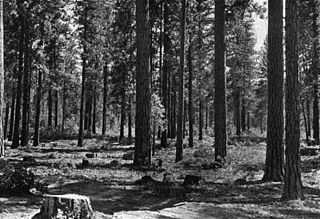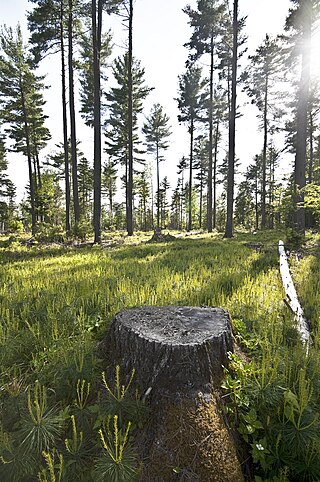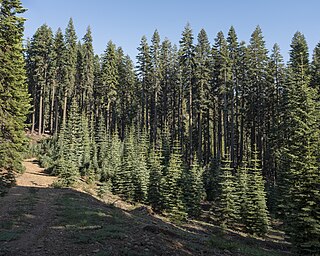
Logging is the process of cutting, processing, and moving trees to a location for transport. It may include skidding, on-site processing, and loading of trees or logs onto trucks or skeleton cars. In forestry, the term logging is sometimes used narrowly to describe the logistics of moving wood from the stump to somewhere outside the forest, usually a sawmill or a lumber yard. In common usage, however, the term may cover a range of forestry or silviculture activities.

Thinning is a term used in agricultural sciences to mean the removal of some plants, or parts of plants, to make room for the growth of others. Selective removal of parts of a plant such as branches, buds, or roots is typically known as pruning.
Silviculture is the practice of controlling the growth, composition/structure, as well as quality of forests to meet values and needs, specifically timber production.

Clearcutting, clearfelling or clearcut logging is a forestry/logging practice in which most or all trees in an area are uniformly cut down. Along with shelterwood and seed tree harvests, it is used by foresters to create certain types of forest ecosystems and to promote select species that require an abundance of sunlight or grow in large, even-age stands. Logging companies and forest-worker unions in some countries support the practice for scientific, safety and economic reasons, while detractors consider it a form of deforestation that destroys natural habitats and contributes to climate change. Environmentalists, traditional owners, local residents and others have regularly campaigned against clearcutting, including through the use of blockades and nonviolent direct action.

Selection cutting, also known as selection system, is the silvicultural practice of harvesting trees in a way that moves a forest stand towards an uneven-aged or all-aged condition, or 'structure'. Using stocking models derived from the study of old growth forests, selection cutting, also known as 'selection system', or 'selection silviculture', manages the establishment, continued growth and final harvest of multiple age classes of trees within a stand. A closely related approach to forest management is Continuous Cover Forestry (CCF), which makes use of selection systems to achieve a permanently irregular stand structure.
Management of Pacific Northwest riparian forests is necessary because many of these forests have been dramatically changed from their original makeup. The primary interest in riparian forest and aquatic ecosystems under the Northwest Forest Plan (NWFP) is the need to restore stream habitat for fish populations, particularly anadromous salmonids. Some of these forests have been grazed by cattle or other livestock. The heavy hooves of these animals compact the soil. This compaction does not allow the water to be absorbed into the ground, so the water runs off into the stream carrying topsoil along the way.
The following outline is provided as an overview of and guide to forestry:
Forest farming is the cultivation of high-value specialty crops under a forest canopy that is intentionally modified or maintained to provide shade levels and habitat that favor growth and enhance production levels. Forest farming encompasses a range of cultivated systems from introducing plants into the understory of a timber stand to modifying forest stands to enhance the marketability and sustainable production of existing plants.
Salvage logging is the practice of logging trees in forest areas that have been damaged by wildfire, flood, severe wind, disease, insect infestation, or other natural disturbance in order to recover economic value that would otherwise be lost.

Carya aquatica, the bitter pecan or water hickory, is a large tree, that can grow over 30 metres (98 ft) tall of the Juglandaceae or walnut family. In the American South it is a dominant plant species found on clay flats and backwater areas near streams and rivers. The species reproduces aggressively both by seed and sprouts from roots and from stumps of cut trees. Water hickory is a major component of wetland forests now in the south eastern US, because of the selective cutting of more desirable tree species for the lumber industry. It is considered important in cleansing drainage waters since the plants slow water flow during flooding, allowing sediments to fall out of the water column. This tree species is tolerant of wet soils but grows best on well draining soils near rivers and other water ways.
Variable retention is a relatively new silvicultural system that retains forest structural elements for at least one rotation in order to preserve environmental values associated with structurally complex forests.

Grafting or graftage is a horticultural technique whereby tissues of plants are joined so as to continue their growth together. The upper part of the combined plant is called the scion while the lower part is called the rootstock. The success of this joining requires that the vascular tissues grow together. The natural equivalent of this process is inosculation. The technique is most commonly used in asexual propagation of commercially grown plants for the horticultural and agricultural trades. The scion is typically joined to the rootstock at the soil line; however, top work grafting may occur far above this line, leaving an understock consisting of the lower part of the trunk and the root system.

Shelterwood cutting is the progression of forest cuttings leading to the establishment of a new generation of seedlings of a particular species or group of species without planting. This silvicultural system is normally implemented in forests that are considered mature, often after several thinnings. The desired species are usually long-lived and their seedlings would naturally tend to start under partial shade. The shelterwood system gives enough light for the desired species to establish without giving enough light for the weeds that are adapted to full sun. Once the desired species is established, subsequent cuttings give the new seedlings more light and the growing space is fully passed to the new generation.

Even-aged timber management is a group of forest management practices employed to achieve a nearly coeval cohort group of forest trees. The practice of even-aged management is often pursued to minimize costs to loggers. In some cases, the practices of even aged timber management are frequently implicated in biodiversity loss and other ecological damage. Even-aged timber management can also be beneficial to restoring natural native species succession.

Mycoforestry is an ecological forest management system implemented to enhance forest ecosystems and plant communities through the introduction of mycorrhizal and saprotrophic fungi. Mycoforestry is considered a type of permaculture and can be implemented as a beneficial component of an agroforestry system. Mycoforestry can enhance the yields of tree crops and produce edible mushrooms, an economically valuable product. By integrating plant-fungal associations into a forestry management system, native forests can be preserved, wood waste can be recycled back into the ecosystem, carbon sequestration can be increased, planted restoration sites are enhanced, and the sustainability of forest ecosystems are improved. Mycoforestry is an alternative to the practice of clearcutting, which removes dead wood from forests, thereby diminishing nutrient availability and reducing soil depth.
When logging began in British Columbia, Canada, in the late 19th century, the overriding concern was to harvest timber in the most economical fashion. Reforestation, aesthetics and protection of fish and wildlife habitat were not issues of great concern.

Gap dynamics refers to the pattern of plant growth that occurs following the creation of a forest gap, a local area of natural disturbance that results in an opening in the canopy of a forest. Gap dynamics are a typical characteristic of both temperate and tropical forests and have a wide variety of causes and effects on forest life.
A mixedwood stand is a forest type in which 26% to 75% of the canopy is made up of softwood trees.
The Maybeso Experimental Forest is an experimental forest on Prince of Wales Island in Alaska. It is located near Hollis, Alaska within the Tongass National Forest and is administered by the United States Forest Service. The area of the forest is approximately 1,101 acres (446 ha), with a peak elevation of 2,953 feet (900 m). The forest was established in 1956 to examine the effects of large-scale clearcut timber harvesting on forest regeneration and anadromous salmonid spawning areas. The Maybeso Experimental Forest is the site of the first large-scale clearcut logging operation in Southeast Alaska, and nearly all commercial forest was removed from the area between 1953 and 1960. Presently, the forest is an even-aged, second-growth Sitka spruce and Western hemlock forest.

Forests play a crucial role as valuable repositories of biodiversity, eradicating the habitat that supports numerous plant and animal species. In Nigeria, this phenomenon has resulted in the endangerment of various trees, shrubs, and animals, with some species facing depletion.











